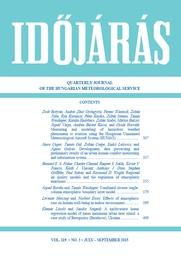IDŐJÁRÁS - angol nyelvű folyóirat
Measuring and modeling of hazardous weather phenomena to aviation using the Hungarian Unmanned Meteorological Aircraft System (HUMAS)
Zsolt Bottyán, András Zénó Gyöngyösi, Ferenc Wantuch, Zoltán Tuba, Rita Kurunczi, Péter Kardos, Zoltán Istenes, Tamás Weidinger, Katalin Hadobács, Zoltán Szabó, Márton Balczó, Árpád Varga, Andrea Bíróné Kircsi, and Gyula Horváth
idojaras.2015.3.1 (p. 307–)
Zsolt Bottyán, András Zénó Gyöngyösi, Ferenc Wantuch, Zoltán Tuba, Rita Kurunczi, Péter Kardos, Zoltán Istenes, Tamás Weidinger, Katalin Hadobács, Zoltán Szabó, Márton Balczó, Árpád Varga, Andrea Bíróné Kircsi, and Gyula Horváth
idojaras.2015.3.1 (p. 307–)
Development, data processing and preliminary results of an urban human comfort monitoring and information system
János Unger, Tamás Gál, Zoltán Csépe, Enikő Lelovics, Ágnes Gulyás
idojaras.2015.3.2 (p. 337–)
János Unger, Tamás Gál, Zoltán Csépe, Enikő Lelovics, Ágnes Gulyás
idojaras.2015.3.2 (p. 337–)
Regional air quality models and the regulation of atmospheric emissions
Bernard E.A. Fisher, Charles Chemel, Ranjeet S. Sokhi, Xavier V. Francis, Keith J. Vincent, Anthony J. Dore, Stephen Griffiths, Paul Sutton, and Raymond D. Wright
idojaras.2015.3.3 (p. 355–)
Bernard E.A. Fisher, Charles Chemel, Ranjeet S. Sokhi, Xavier V. Francis, Keith J. Vincent, Anthony J. Dore, Stephen Griffiths, Paul Sutton, and Raymond D. Wright
idojaras.2015.3.3 (p. 355–)
Combined closure single-column atmospheric boundary layer model
Árpád Bordás and Tamás Weidinger
idojaras.2015.3.4 (p. 379–)
Árpád Bordás and Tamás Weidinger
idojaras.2015.3.4 (p. 379–)
Effects of atmospheric ions on human well-being in indoor environment
Levente Herczeg and Norbert Érces
idojaras.2015.3.5 (p. 399–)
Levente Herczeg and Norbert Érces
idojaras.2015.3.5 (p. 399–)
A multivariate linear regression model of mean maximum urban heat island: a case study of Beregszász (Berehove), Ukraine
Elemér László and Sándor Szegedi
idojaras.2015.3.6 (p. 409–)
Elemér László and Sándor Szegedi
idojaras.2015.3.6 (p. 409–)
IDŐJÁRÁS folyóirat

Az IDŐJÁRÁS a HungaroMet Nonprofit Zrt. negyedévenként megjelenő angol nyelvű folyóirata
Megrendelhető a journal.idojaras@met.hu címen.
A szerzőknek szánt útmutató itt olvasható.
Megrendelhető a journal.idojaras@met.hu címen.
A szerzőknek szánt útmutató itt olvasható.










